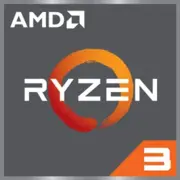AMD Ryzen 3 5305GE

AMD Ryzen 3 5305GE: Budget APU for Energy-Efficient Systems
March 2025
Key Features: Architecture and Performance
Cezanne Architecture and 7nm Process Technology
The AMD Ryzen 3 5305GE is built on the Zen 3 microarchitecture (codename Cezanne) and manufactured using a 7-nanometer process technology. This APU (Accelerated Processing Unit) combines CPU and GPU on a single chip.
- 4 cores / 8 threads thanks to Simultaneous Multithreading (SMT).
- Clock Speeds: base — 3.6 GHz, max turbo boost — 4.2 GHz.
- Cache: 8 MB L3, enhancing responsiveness in multitasking.
- Integrated Graphics: Radeon Vega 6 (6 compute units, frequency up to 1.7 GHz).
- TDP: 35W — focused on energy-efficient systems.
Key Features:
- Support for PCIe 3.0 (APU Cezanne limitation).
- Power-saving technologies Precision Boost 2 and Adaptive Power Management.
- Built-in DDR4 memory controller.
Compatible Motherboards: Sockets and Chipsets
AM4 Socket: Versatility and Availability
The Ryzen 3 5305GE uses the AM4 socket, compatible with the following chipsets:
- A520 — a budget option for basic builds.
- B550 — the optimal choice (supports PCIe 4.0 for storage).
- X570 — for enthusiasts, but excessive for this CPU.
Board Examples:
- ASRock B550M-HDV ($75–90): compact form factor, two M.2 slots.
- Gigabyte A520M S2H ($60–70): minimalist board for office PCs.
Important:
- Updating the BIOS may be necessary to activate Zen 3 features (use boards with the Q-Flash Plus button).
- Avoid older chipsets (A320) as they limit performance.
Supported Memory: DDR4 as the Foundation
Optimal Configurations
The processor works only with DDR4 (DDR5 is not supported):
- Recommended Frequency: 3200 MHz (maximum official support).
- Dual-channel mode is essential to unlock Vega 6’s potential.
Build Examples:
- Budget: 2x8 GB DDR4-2666 ($40–50).
- Optimal: 2x8 GB DDR4-3200 CL16 ($55–65).
Tip: Use memory with low timings (CL16) to increase FPS in games by 10–15%.
Power Supplies: Power Calculation
Energy Efficiency First
With a TDP of 35W, the Ryzen 3 5305GE does not require a high-wattage PSU:
- Build without a discrete GPU: 300–400W is sufficient (e.g., Be Quiet! System Power 10 400W, $45).
- With an NVIDIA GTX 1650 GPU: 450–500W (Corsair CX450, $55).
Recommendations:
- Choose power supplies with an 80 Plus Bronze certificate or higher.
- For mini-PCs, compact solutions like the FSP FlexGURU 300W are suitable ($60).
Pros and Cons of the Processor
Strengths:
- Energy Efficiency: ideal for quiet and compact systems.
- Integrated Graphics: Vega 6 handles gaming at 720p/1080p on low settings (e.g., CS2 — 60–70 FPS).
- Price: in 2025, the model is priced at $100–120, which is cheaper than Intel Core i3 with similar specs.
Weaknesses:
- 4 cores: insufficient for heavy workloads (rendering, streaming).
- PCIe 3.0: limits the speed of modern NVMe storage.
- No DDR5 support: future memory upgrades will require CPU and motherboard replacement.
Usage Scenarios: Where It Shines
Office and Multimedia
- Work with documents, browsers (20+ tabs), Zoom conferences.
- 4K video playback (hardware decoding via Vega 6).
Light Gaming
- eSports: Dota 2, League of Legends, Overwatch 2 — 60+ FPS at 1080p.
- Indie Games: Hollow Knight, Stardew Valley — stable 120 FPS.
Home Server/Media Center
- Low power consumption allows using the CPU in a NAS based on Proxmox or Plex.
Comparison with Competitors
AMD Ryzen 5 5600G ($130–150)
- Pros: 6 cores/12 threads, Vega 7 (15% faster).
- Cons: Higher price and TDP (65W).
Intel Core i3-12100 ($110–125)
- Pros: Higher IPC in single-threaded tasks.
- Cons: No integrated graphics (requires a separate graphics card).
Conclusion: The Ryzen 3 5305GE outperforms competitors in budget builds focused on energy efficiency and integrated graphics.
Practical Assembly Tips
1. Case: choose models with good ventilation (Cooler Master Q300L, $50).
2. Cooling: the stock cooler is sufficient, but for quiet operation consider the DeepCool AK400 ($30).
3. Storage: NVMe SSD with PCIe 3.0 (Kingston NV2 1TB, $60).
4. BIOS: enable XMP mode for memory and Precision Boost Overdrive for auto-overclocking.
Example build for $400:
- CPU: Ryzen 3 5305GE ($110).
- Motherboard: ASRock B550M-HDV ($80).
- Memory: 2x8 GB DDR4-3200 ($60).
- Storage: NVMe 512 GB ($45).
- PSU: Be Quiet! System Power 10 400W ($45).
- Case: Tecware Forge M2 ($60).
Final Conclusion: Who Is the Ryzen 3 5305GE Suitable For
This processor is an ideal choice for:
- Office PCs: quiet operation, low energy consumption.
- Home Theater PCs: 4K support, compact cases.
- Budget Gaming Systems: for less demanding games without a discrete graphics card.
- Entry-Level Servers: low TDP reduces electricity costs.
Why this one? The combination of price, integrated graphics, and energy efficiency makes the Ryzen 3 5305GE unique in its category. However, for tasks requiring multithreading (video editing, 3D modeling), it's better to consider Ryzen 5 or Intel Core i5.
This article is relevant as of March 2025. Prices may vary by region and availability of promotions.
Basic
CPU Specifications
Memory Specifications
GPU Specifications
Miscellaneous
Share in social media
Or Link To Us
<a href="https://cputronic.com/cpu/amd-ryzen-3-5305ge" target="_blank">AMD Ryzen 3 5305GE</a>